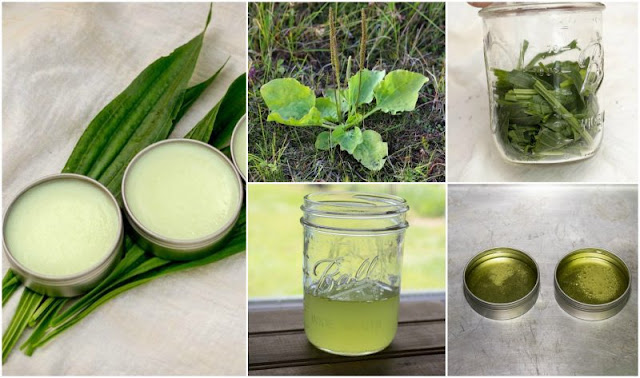Plantain is one of those magical herbs that can be found almost anywhere. It’s used in many cultures as a “healing herb” due to its amazing healing properties. Most people view this herb as a weed. It’s very prolific and will pretty much grow anywhere. Don’t toss it in the compost just yet! Harvest the leaves to make a first aid healing salve.
How to Identify Plantain
There are two varieties of plantain commonly seen in the average yard: Plantago major, or more commonly known as broadleaf and Plantago lanceolata, also known as narrowleaf. I have mostly narrowleaf in my yard. In fact, I have patches of it growing in my garden. I just leave it and harvest from it when I need it. Both varieties have several leaves which surround the flowers and the stem at the base like flower petals.
 |
| Plantago major, rounded leaves. |
 |
| Plantago lanceolata. Pointed, narrow leaves. |
Remember, when harvesting plantain, make sure you are gathering them from an area not treated with chemicals.
Supplies
A handful of Plantain leaves (washed and dried)
8 oz Heatproof jar (not shown)
Saucepan (not shown)
Directions
Add Plantain to the Jar
Tear the plantain leaves into smaller pieces and fill the jar half full. Pack the leaves in there tightly.
Add Coconut Oil
Add the coconut oil on top of the leaves. Put the jar in a saucepan and fill the pan about halfway up the jar with water. Set the heat on a low simmer and let the oil infuse for about two hours.
Strain
After the oil infuses for a couple of hours, strain out the plantain leaves. The oil will be a pretty light green.
Add the beeswax
Add the beeswax to the infused oil and put in back into the saucepan until the beeswax melts. The beeswax will help keep the salve firm at room temperature.
Pour into Jars or Tins
Pour the oil mixture into tins or jars—my batch made 6 oz. Let the salve cool. It will become opaque as it cools.
Add to Your First Aid Kit
Use the salve on minor cuts and burns. The coconut oil and beeswax will help keep the skin moist and the plantain will promote healing. The salve is also great for healing chapped hands and sunburned skin. Use the salve on your pets too! It’s great on sore paws.
Plantain is also great for bee and wasp stings, mosquito bites, poison ivy, eczema, psoriasis and nappy rash.









